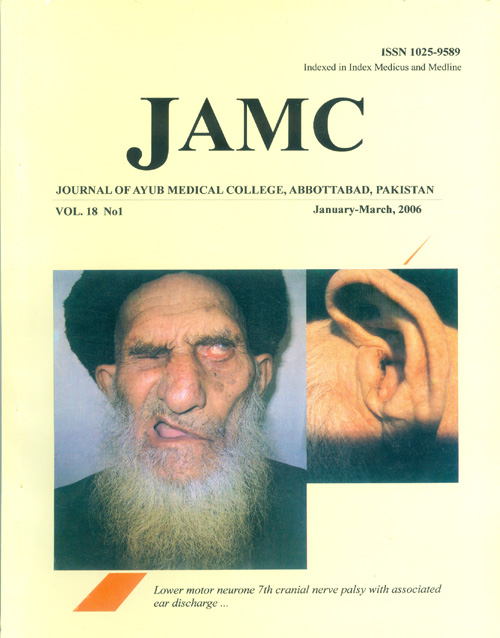FREQUENCY OF HYPERTENSION IN STROKE PATIENTS PRESENTING AT AYUB TEACHING HOSPITAL
Abstract
Background; Stroke is a frequent medical problem occurring in patients with hypertension andother risk factors. The objective of this study was to find the frequency of hypertension asimportant risk factor in stroke patients presenting at Medical 'B' unit of Ayub Teaching Hospital,Abbottabad from November 2003 to January 2005. Methods: Patients who clinically presentedwith features of stroke and then confirmed on C.T scan were included in this study. Otherunderlying risk factors were diabetes mellitus, smoking, cardiovascular disease and dyslipidemia.Result: Hypertension was found to be the most common risk factor in current study. Out of 91cases, 51 (56.04%) were suffering from hypertension. Thirty five patients were male and sixteenpatients were female. Peak stroke prone age was 61-70 years in males and 51-60 years in females.Conclusion: Hypertension is the leading risk factor of stroke. It is therefore essential to detect andtreat hypertension at its outsetKeywords: Stroke, Hypertension, Risk factors, CT scanReferences
Park JE, Park K. Stroke: Textbook of Preventive and Social
Medicine. 15th ed. Jabalpur. M/S Banarsidas Bhanot
Publisher, 1995: 245-46
Ali L, Jamil H, Shah M.A. Risk factors and stroke. J Coll
Phys Surg Pak 1997; 7(1):7-10.
Ralph SL. Pathogenesis, classification and epidemiology of
cerebrovascular disease. In: Lewis P, Rowland, eds Merit’s
Textbook of Neurology. 9th ed. Baltimore. Williams and
Wilkins 1995:227-42.
Guieb M, Perez MC. Epidemiologic assessment of stroke.
MMC Proceedings 1998; (11):48-52.
National Health Survey of Pakistan 1990-94. Pakistan
Medical Research Council Islamabad, Pakistan1998.
Hugh S Markus. Stroke; Causes and clinical features.
Medicine International 2005, 5 (1): 36-40
He J, Klag MJ, Wu Z, Whelton PK. Stroke in peoples
Republic of China II. Metanaylsis of Hypertension and risk
of stroke. Stroke 1995 Dec; 26(12):2228-32
Thrift AG, Mc Neil JJ, Forbes A, Donnan GA, Risk factors
for cerebral hemorrhage in the era of well controlled
hypertension. Melbourne Risk Factor Study (MERFS)
Group. Stroke 1996; 27 (11): 2020-5
Factors important in arterial narrowing. Schwartz S.M;
Reidy M.A et all J Hyperten Suppl. 1996; 14(5): S71-81.
Aho K, Harmsen P, Hateno S, Maarqyardsen T, Smirnov
VE, Strasser T. On behalf of the participants in the W.H.O
collaborative study on control of stroke in the community.
Cerebrovascular diseases in the community results of the
W.H.O collaborative study. Bulletin of W.H.O, 1998; 58:
-130.
Matenga J, Kitai I, Levy L. Stroke among black people in
Harare, Zimbabwe. Results of computer tomography and
associated risk factors. Br. Med J Clin Res Ed, 1986;292:
-51.
J Ayub Med Coll Abbottabad 2006;18(1)
Fayyaz M, Hassan MA, Attique MUH. Risk and early
prognosis in Stroke. Annals 1999;5(1):12-15
Vohra EA, Ahmad WU, Ali M. Etiology and Prognostic
Factors of Patients Admitted for Stroke. J Pak Med Assoc
Khawaja I, Shakoor Z. Hypertension is a major factor in men 2000;50(7):234-6
and women of all ages. JPIMS 1993; 4, (1): 191-194. 17. Bornstien NM, Aronovick BD, Karepov VG, Traves TA,
Oved M, Kerczyn AD. The Tel Aviv Stroke Registry. 3600
consective patients. Stroke 1996;27(10): 1770-3
Al Rajeh S, Adnan A, Gulzar N, Emmanuel L. Stroke in a
Saudi Arabian National Guard community; analysis of 500
consecutive cases from a population based hospital. Stroke
: 24:1635-9.
Shuaib A, Boyle C. Stroke in the elderly. Curr-Opin-Neurol.
: 7(1): 41-71.
Broderick J, Brott T, Basan W, Haley EC, Levy D, Marler J,
Sheppard G. Blum C. Blood pressure in the first minutes of
focal cerebral ischemia. Ann Emerg Med 1993;22:1438-43.
Issue
Section
License
Journal of Ayub Medical College, Abbottabad is an OPEN ACCESS JOURNAL which means that all content is FREELY available without charge to all users whether registered with the journal or not. The work published by J Ayub Med Coll Abbottabad is licensed and distributed under the creative commons License CC BY ND Attribution-NoDerivs. Material printed in this journal is OPEN to access, and are FREE for use in academic and research work with proper citation. J Ayub Med Coll Abbottabad accepts only original material for publication with the understanding that except for abstracts, no part of the data has been published or will be submitted for publication elsewhere before appearing in J Ayub Med Coll Abbottabad. The Editorial Board of J Ayub Med Coll Abbottabad makes every effort to ensure the accuracy and authenticity of material printed in J Ayub Med Coll Abbottabad. However, conclusions and statements expressed are views of the authors and do not reflect the opinion/policy of J Ayub Med Coll Abbottabad or the Editorial Board.
USERS are allowed to read, download, copy, distribute, print, search, or link to the full texts of the articles, or use them for any other lawful purpose, without asking prior permission from the publisher or the author. This is in accordance with the BOAI definition of open access.
AUTHORS retain the rights of free downloading/unlimited e-print of full text and sharing/disseminating the article without any restriction, by any means including twitter, scholarly collaboration networks such as ResearchGate, Academia.eu, and social media sites such as Twitter, LinkedIn, Google Scholar and any other professional or academic networking site.









